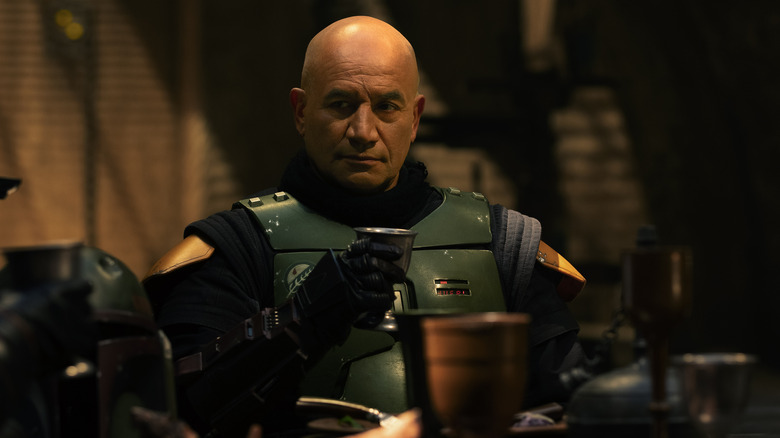
Directed by noted TV director Kevin Tancharoen, the fourth episode of "The Book of Boba Fett" goes back into the timeline to offer answers to things we already knew, but delivers them in a satisfying way. The vast majority of the episode plays in the past, with Boba Fett dedicated to retaking his ship from the clutches of Bib Fortuna in Jabba's Palace. Along the way, he is able to save Fennec Shand (after her run in with the Mandalorian and Toro Callican) and, after stealing the ship back, Boba Fett gets revenge on the Kintan Striders swoop gang for killing the Tuskens who took him in. Then, he sets his sights to finding his armor and kills the Sarlacc in the process. In the present, a droid lets Boba Fett know that he's fully healed, likely putting an end to the flashbacks on the show.
There, Boba Fett tries to rally muscle and opposing families of Mos Espa to his cause of wiping out the Pyke Syndicate from Tatooine.
The Direction And Film References
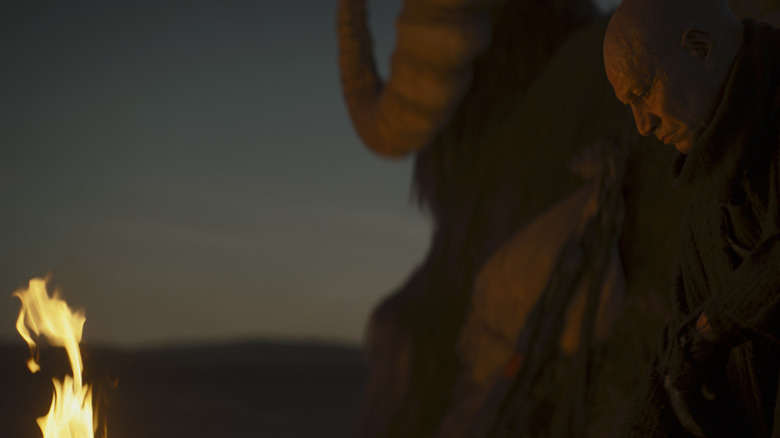
There is something very Kurosawa-like about Boba Fett's rescue of Fennec Shand and bringing her into the desert to heal, reminiscent of Toshiro Mifune's fate midway through "Yojimbo" (1961). The Mod Parlor reminds one of a mix between "Blade Runner" (1982) and '90s cyberpunk films like "Johnny Mnemonic" (1995).
Everything set in the Dune Sea with Boba Fett looks like a classic John Ford film, taking cues from "The Searchers" (1956) as well as others. "The Searchers" has long been an inspiration on "Star Wars" and "Attack of the Clones" in particular. Watch me talk about that here:
There can also be no doubt that the sit down dinner between Boba Fett and the other families of Mos Espa is a reference to the sit down Vito Corleone has with the other families after the death of Sonny in "The Godfather" (1972).
Tanchoaren is able to keep the action lively and create callbacks to other great moments and ideas in "Star Wars" despite the fact that episode feels like a retread of information we already mostly had. Thanks to the second season of "The Mandalorian," we know most everything that has transpired between he and Fennec Shand, from her rescue and repair to her joining him in his quest to take back Tatooine. We also know that Boba hunts for his armor and gets his ship back.
The thing this episode really gives us is a motivation for Boba Fett, tired of almost dying because he's working for idiots.
The Cameos
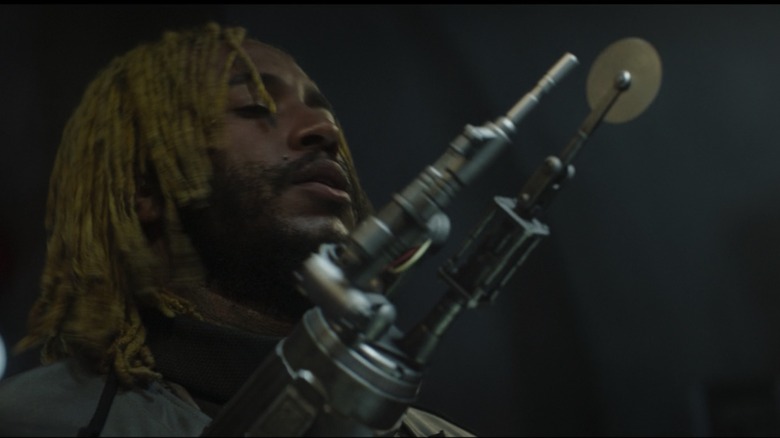
The biggest cameo of this episode comes in the form of Stephen "Thundercat" Bruner, who first made a name for himself joining the band Suicidal Tendencies. He plays the Mod Artist inside the very tattoo-like Mod Parlor. The cybernetic modifier is a part important to many movies and always a fascinating cameo, from James Hong in "Blade Runner" (he just does the eyes) to Peter Stormare in "Minority Report" (2002). Thundercat plays the role with glee, like he seems to be enjoying the fact that he's in "Star Wars." The scene also gives further information about the Mods themselves, and gives us a small peek into that sub-culture on Tatooine.
The other big cameo was the return of Matthew Wood. He's the supervising sound editor on the show, but has been the voice and face of Bib Fortuna since 1999's "The Phantom Menace." Here, he comes back as the slimy Twi-lek in flashbacks of Boba Fett killing him, something that we'd only glimpsed in the post-credits tease of "The Mandalorian." Wood also voices many of the droids and was the man behind General Grievous in "Revenge of the Sith" (2005).
What To Look Out For
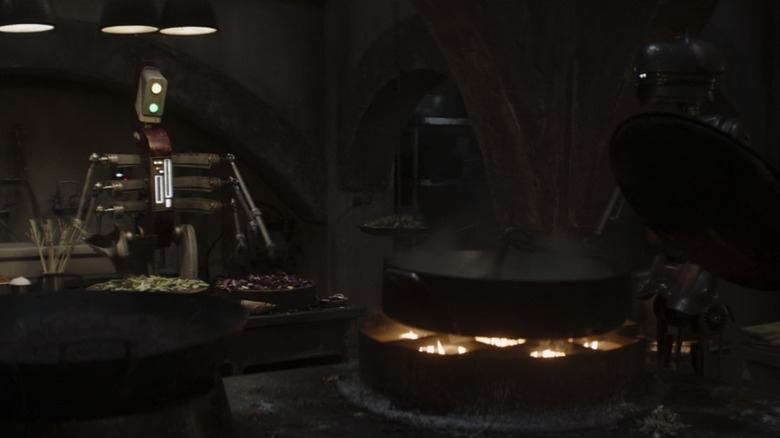
This episode featured a lot of things that harkened back to previous movies, but the most extensive references seemed to be in the droids that appeared throughout the episode.
We finally see the kitchen of Jabba's palace and find it run by two droids. The first is a COO-series cook droid. These multi-armed cook droids were first seen in "Attack of the Clones" aboard the refugee transport that Anakin and Padmé take to get back to Naboo. The other is an EV-series droid acting as the Sous Chef. EV-9D9 was a pivotal character from Jabba's palace in "Return of the Jedi" but it feels unlikely that this droid is the same one, despite the uncanny match of voice.
The third droid we see in the kitchen is the rat catcher. This little bunny-style droid is a LEP-series service droid, which came from an original concept Doug Chiang created for "The Phantom Menace." They were seen extensively in "Star Wars: The Clone Wars" often as comedic relief. They're adorable and scared, and this one is no different. This marks their first appearance in live action.
There are a lot of subtle references to other bits of "Star Wars" in the dialogue of the episode. Boba Fett offers Fennec Shand a scurrier to eat at one point; these rat-like creatures first appeared in the Special Edition of "A New Hope" (1977) scurrying away from Luke's landspeeder on its approach to Mos Eisley. Now, Boba Fett catches and eats them with joy.
At one point, Fennec tells Boba Fett that the mayor's majordomo is "singing like a Yuzzum." In the Special Edition of "Return of the Jedi" (1983), the Max Rebo band got another singer: Joh Yowza. This grizzly voiced Yuzzum played duets with Sy Snootles and could really wail.
One of the most legendary rivalries in "Star Wars" has been that of Wookiees and Trandoshans, where Trandoshans traditionally hunt Wookiees and keep their pelts. This age-old rivalry explains Black Krrsantan getting drunk and pulling the arms from a Trandoshan inside Garsa Fwip's Sanctuary. Fwip does her best to deescalate the situation, but there's not much to be done about a drunk Wookiee with a bloodlust. Krrsantan is the sort that gives Wookiees the reputation of tearing people's arms off.
Slave I
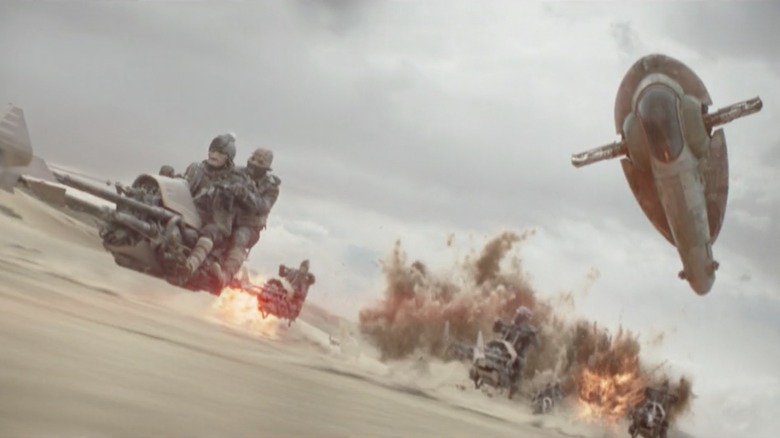
Boba Fett goes after his ship in Jabba's Palace. Known for years as "Slave I" he refers to it as a Firespray here. This is nothing new. This type of ship has been labeled a Firespray in the canon for decades. Some fans are worried that Lucasfilm is going to change the name of Boba Fett's ship because of the negative connotations of slavery, but this episode shows they'd rather just leave it be and find other ways of referring to it, which is fine. Despite what you might hear on the internet, this is no cause for alarm.
It was delightful to see the ship face off against the Sarlacc. It was a clever bit of scene design to see the Sarlacc without its beak, letting audiences think it might be dead, then using the Sarlacc's beak (added in 1997) as a jump scare while Boba Fett searches for his armor, not realizing that the Jawas had taken it. Fennec and Boba Fett are able to finally kill the Sarlacc using a seismic charge, one of the most visually and audibly arresting weapons in "Star Wars" first seen in the asteroid chase above Geonosis in "Attack of the Clones" (2002).
The Timeline
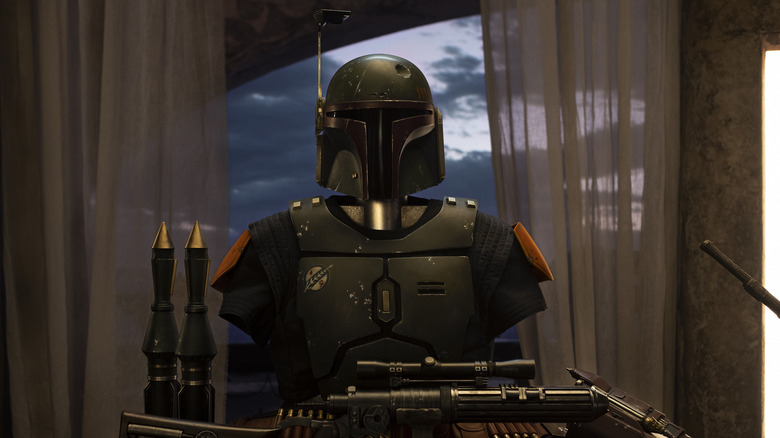
The timeline of this show is still squishy, and it gets even more complicated when Boba Fett mentions in this episode that he spent years with the Tusken Raiders. It did not feel in previous episodes like years had passed, but even if a minimum of two years had passed, we can still keep the events of "The Mandalorian" and the present-timeline of "The Book of Boba Fett" somewhere between three and seven years after "Return of the Jedi." As I've said before, don't expect a hard answer about exactly when the show is set until there is a specific reason to do so. And since "The Mandalorian" and its spin-offs are the biggest, highest profile projects happening in this part of the timeline, don't expect them to tie themselves down to giving any specific dates or timeframes.
The Verdict
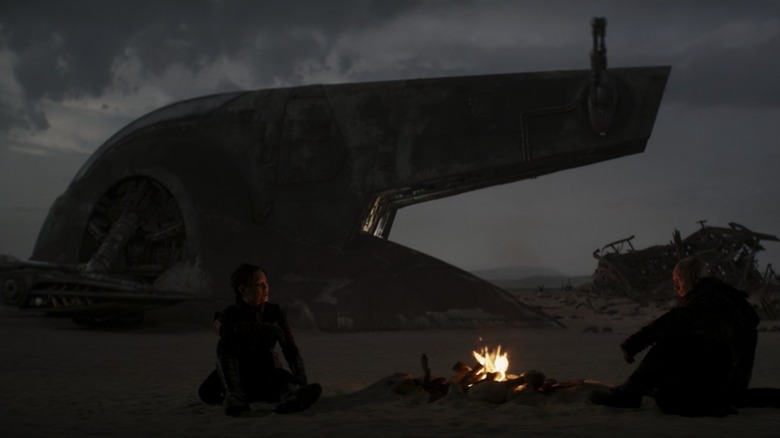
This was another episode that was a lot of fun, despite having little to offer in terms of forward momentum for the show. It showed us things that we had already learned in previous parts of the timeline, making it a little tedious at times. It definitely offered a new shade of reason for the motivations of Boba Fett, but still hasn't entirely answered questions about his complete character transformation.
This episode also seemed to close the door on further flashbacks, which is a shame. Of the events I had hoped to see from different angles, the story of Cobb Vanth and Boba Fett's armor in Mos Pelgo, first written down by Chuck Wendig, is something I wanted to see.
Looking for meaning in this episode, it really feels as though loyalty is something Boba Fett has been searching his life for. With his father, he had complete trust and loyalty, and then he grew up working with or for scughole after scughole. Cad Bane and Aurra Sing betrayed and used him as a kid. Jabba sold him out and hunted him during his time employed for the Hutt. He wants the security he had as a kid, and creating his own family is the way to do it. He found that with the Tuskens and found his life more simple that way. That's why his offer of family and loyalty to Fennec Shand is so powerful, and she recognizes it.
This episode didn't do a whole lot to carry the story forward, but it did offer us more shades of gray in the complex tapestry of Boba Fett's character and the shifts he has taken over the years. And it gave us some really fun "Star Wars." Let's just hope that in the final accounting it means something.
"Book of Boba Fett: Chapter 4 - The Gathering Storm" is now playing on Disney+. New episodes of "The Book of Boba Fett" premiere on Wednesdays.
You can find Bryan Young on Twitter.
Read this next: The 12 Best Boba Fett Moments In Star Wars Shows And Movies
The post The Book of Boba Fett Delivers an Origin Story Before 'The Gathering Storm' appeared first on /Film.
0 Comments